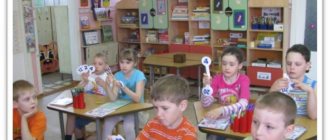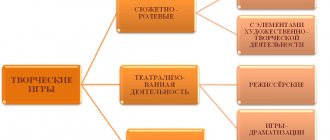Game activity methods
Currently, the scientific literature on the theory of gaming activity practically does not describe methods of gaming activity.
Let's consider the methods developed by A. M. Novikov and D. A. Novikov in “Methodology” (2007) proposed a classification of methods. The authors highlight theoretical and empirical methods from a set of gaming activity methods. And within these groups: Method-operations and method-actions.
Theoretical method-operations are considered as mental operations: Analysis and synthesis, comparison, generalization, specification, etc. On the one hand, they are formed in childhood, including during play activities; on the other hand, play activities are carried out with their help. In addition to the operations of logical thinking, the operations of the theoretical method of gaming activity can also include (perhaps conditionally) imagination as the mental process of creating new ideas and images with its specific forms of fantasy (creating implausible, paradoxical images and ideas) and dreams (as creating images of what is desired).
Theoretical and methodological action, such as the analysis of epistemological systems, theories as a method, etc., is practically not implemented in gaming activities, with the possible exception of such complex games as chess.
Empirical methods include primarily observation and experiment. In this case, the experiment is considered by the authors not in the scientific sense, as a strict procedure of scientific research, but as a synonym for experience, as an attempt to implement something, to make some changes in the external environment. Observation and experiment in this sense are two sides of the same coin. Observation is like searching for an answer to the question “what is happening?” Experimentation is “what will happen if you do this and that?” A child breaks toy structures and toys - this, according to the authors, is a natural manifestation of an exploratory reflex aimed at learning the properties of objects. Children's pranks of older children - blowing something up, setting it on fire, slapping it, etc. - also experiments characteristic of this age. Finally, competitive games: who is stronger? Who is faster? who is smarter? These are also experiments in the form of tests. Even when a person plays alone, for example, plays solitaire, this is also a test for himself - “will I succeed or not?”
Exercises are also considered as a method of playful activity. As you know, training is based on repeated repetition of certain movements and actions to form and improve skills and abilities. The child is ready to repeat a pleasant gaming activity many times, improve his skills and consolidate his success. When an action becomes a habit, a daily routine, the child loses interest in it - the action is mastered and consolidated.
Design in gaming activity is the creation of various structures. First there are “pastry cakes” made of sand, “construction” of houses, pyramids from bricks, then games with all kinds of building blocks, and later - creation of models of airplanes, ships, etc.
The example method is used in almost all collective games related to the performance of certain actions. So, as an example they can serve: an example of the actions demonstrated by the leader; behavior of adults and peers; images of heroes from books and films, people of different professions, etc.
Imitation (imitating someone or something, trying to reproduce something exactly). From infancy, a child imitates adults in everything - facial expressions, gait, pronunciation of words, etc. Later, imitation develops into a role in children's role-playing games. Imitation is often used as a method in theatrical games, plays, drama, pantomime, etc.
History of the development of gaming technologies in domestic and foreign pedagogy
The idea of using technology in the educational process arose at the beginning of the 20th century. The concept of pedagogical technology was conceptualized by such scientists as V.P. Bespalko, T.A. Ilyina, F.P. Fradkin, M.V. Clarin, G.K. Selevko, N.E. Shchurkova and others is understood and realized, so much so that UNESCO considered it necessary to give it a definition: “This is the definition of principles and the development of methods for optimizing the educational process through the analysis of factors that increase pedagogical effectiveness, through the development and application of methods and materials, as well as through the assessment of used methods." The modern understanding of educational technology is based on the fact that it is an introduction to pedagogy of a systemic way of thinking and is a variation of the learning process.
The analysis conducted by the researchers indicates that the pedagogical phenomenon, which today is called “educational technology,” has been the subject of debate and scientific debate for many centuries. According to scientists, not a single outstanding teacher could avoid this problem.
Even Democritus (460-371 BC) argued that it is better to achieve virtue through internal motivation and conviction than through edification, law and coercion. Marcus Fabius Quintilian (c. 35-96) wrote: “Learning should give him (the student) pleasure...”
In the modern interpretation, the views of the ancient authors sound like this: both of them talk about the attitude towards the child in the process of his upbringing and education, and Quintilian points out the need for children to experience success in their activities as the most important factor in the further development of the individual. In this case, the forms of influence are chosen in such a way as to awaken in the child a desire to improve.
The Italian utopian philosopher T. Campanella, in his book “City of the Sun,” applies the idea of non-violence in pedagogical influence and illustrates it using the example of technological design of the physical environment. The French humanist Monty (1533-1592) said: “It is desirable that he be able not only to captivate with his story, but also to listen to his student.” He reaches the highest level of technological generalization when describing “communication with others,” emphasizing the following in his recommendation:
- do not expose yourself;
- refrain from using knowledge;
- avoid arrogance, etc.
Accepting the thesis that the basis of education should be “skillful distribution of time, subjects and methods,” Ya.A. Comenius (1592-1670) created a pedagogical technology based on the principle of flow and maintaining a dominant position in modern society (Comenius Y.A. “The Great Didactics”).
The formation of pedagogical technology in domestic pedagogy was considered as the essence of the ongoing study of changes in pedagogical technology at the turn of the 20th-21st centuries. K.D. Ushinsky (1824-1870), the founder of scientific pedagogy in Russia, when developing the theory of pedagogy, used the laws of philosophy, history, anatomy, physiology and other sciences, since they all study human nature, that is, he took an anthropological approach to personality as a basis. The pedagogical technology of L.N. Tolstoy was the moral education of the individual, and S.T. Shatsky (1878-1934), who studied the influence of the environment on the student, expanded the concept of pedagogical technology, showing the natural results of its impact on both the individual and the team.
Some researchers of the history of the formation and education of the concept of “pedagogical technology” (Bespalko V.P., Ignatiev S.T., Melekhin V.A., Maslova N.P., Shchurkova N.E., etc.) have proven that the term “ technology" in domestic pedagogy was first used in the 20s of the 18th century.
In the 30s of the 20th century, a unique situation arose in pedagogical science and practice, which was characterized by creative search. New programs and methodological recommendations for organizing the educational process were created, emphasizing the optional nature of these programs, which opened up space for teachers’ pedagogical creativity. Projects have been proposed to convert secondary schools into technical colleges.
The state of play activity of modern preschoolers
The features of the play of modern preschoolers were studied in the work of E. O. Smirnova and O. V. Gudarev “Play and voluntariness in modern preschoolers.” Based on the levels identified by D.B. Elkonin, the authors tried to evaluate the content of the play of modern children of three age groups: middle (from 4-5 years old), older (5-6 years old) and preparatory (from 6-7 years old). At a specially designated time, a small group of children (four to five people) was invited to play any game in a familiar kindergarten room. Each child's type of play activity was assigned to one of the levels of play and categorized as an action role, a story role, and a relational role.
The results of observations showed that the majority of modern children aged 4-6 years reduced the game to simple, uncomplicated actions and individual remarks addressed to a partner. The highest stage of play development, when role relationships are clearly expressed and the child’s behavior is connected with partners (play relationships), occurs only in some children after 5 years.
The next question that was investigated in this work is: how does a decrease in the level of play affect the formation of one of the most important new formations of preschool age - arbitrariness.
The work of Z. Manuylenko (1948) [2] is often cited as proof of the leading role of play in the formation of voluntariness. In this work, the indicator of volitional behavior was the time of maintaining a posture of immobility demonstrated in the game (when performing the role of a guard) and outside the game (at the request of an adult). The results showed that during the heyday of role-playing games (age 4-5 years), the time to maintain a pose in a game was more than three times higher than the same indicator in a non-play situation. At the age of 6-7 years, these indicators converge due to the rapid growth of non-playing volitional qualities, and the time to maintain a pose in play and non-play situations is almost comparable.
In this work, the playing role acts as an external means that establishes the zone of next development, which then “rotates” and is internalized. Thus, voluntariness is transformed into a personal ability that does not depend on the current situation.
The experiments described above were carried out in the middle of the last century, when the quantity and quality of gaming activities was much higher. Do these models still exist today? To answer these questions, an experiment was conducted in which the technique of 3. V. Manuylenko was used. In order to bring the plot of the game closer to modern conditions, children were offered not the role of a security guard, but the role of a “security guard protecting the bank from fraudsters.” The essence of the role-playing game has not changed, but the content of the role has become more clear. Otherwise, the experimental situation, the ages studied, the observed indicators and their processing exactly repeated Manuylenko’s studies.
However, the data of preschoolers of the 21st century were radically different from the results of children of the middle of the last century. In Fig. Figure 1.3 shows the dynamics of volitional behavior in and outside of play among preschoolers of two generations. The presented graph clearly demonstrates a number of significant differences in the stage of development and dynamics of volitional behavior.
Firstly, modern preschoolers have significantly lower absolute indicators of volitional behavior. Even in the preparatory group, our children cannot hold a pose for more than 3 minutes, while their peers of the previous generation could hold a motionless pose for an average of 12 minutes. These differences clearly indicate a decrease in the ability to self-control and manage one's own behavior.
Characteristics of children's musical and play activities
Play is the leading type of activity for preschool children. It is considered in preschool pedagogy as one of the main methods of education, training and as one of the forms of organizing children's activities.
Expanding the concept of “leading activity” and emphasizing the importance of play in the development of a child, A.N. Leontiev wrote: “We call leading activity such activity in connection with which the most important changes occur in the child’s psyche and within the framework of which psychological processes develop that prepare the child’s transition to a new, higher stage of his development.” In this context, we call it “leading.” activities."
In psychology and pedagogy, there are many views on play, theories, both foreign (W. Wundt, V. Stern, J. Dewey, K. Büller, J. Piaget, etc.) and their own (L. S. Vygotsky, R. Zaporozhets, A.V. Keneman, A.N. Leontyev, F.S. Levin-Shirina, T.A. Markova, D.V. Mendzheritskaya, S.L. Rubinshtein, K.D. Ushinsky, E.I. Tikheeva, D.B. Elkonin and others).
Some games go back thousands of years (like the hopscotch game). The game is diverse not only in its content, but also in its forms and sources.
Games perform various functions in the lives of children: educational, formative, educational, developmental, cognitive, recreational, communicative, organizational, value-oriented, etc.
In the game, the child consolidates his experience of knowing the world and its changes, the child’s comprehensive development is realized - emotional, intellectual, creative. There are games aimed at mastering moral norms and rules of behavior, socializing preschool children - acquiring life and social experience of adults, developing work skills, physical, aesthetic, spiritual development, and speech development.
Some games are aimed at developing the skills of children of any type of activity, others - at certain personal qualities (communication, perseverance, will, independence, activity), and the development of skills (general or specific).
The game was considered in pedagogy as a means of acquiring, consolidating and deepening knowledge, as a method of teaching preschoolers, its developmental significance was emphasized (E.I. Tikheeva, D.V. Mendzheritskaya, A.P. Usova, etc.).
There are studies that reveal the role of play in the development of volitional behavior (A. V. Zaporozhets, Z. V. Manuylenko, etc.), due to the child’s orientation toward the pattern of action contained in the intended role (i.e., hidden control).
Among the various types of games, didactic games are distinguished. Regardless of the type, a didactic game has a certain structure. A game used for educational purposes must contain a teaching (and educational) task, children’s play actions and the rules of the game1.
Conducting didactic games includes familiarization with the content, explanation of the course of the game and its rules, demonstration of game actions, repetition of the game in various versions with their gradual complication.
Based on the type of material used, didactic games are divided into games with objects, board games with pressure and word games.
A distinction is made between games in the classroom and in children's independent activities.
R.R.I. Zhukovskaya revealed the influence of didactic games in the classroom on children’s independent play, in which role-playing actions showed behavior options and revealed relationships between people [4].
Psychologists and educators emphasize the developmental value of role-playing play as the highest form containing enormous creative potential.
In the game, emphasizes A.N. Leontyev, there are real actions of the child (play role), but in imaginary situations. Playful activities stimulate the imagination. Games with an imaginary situation in their development turn into narrative role-playing games with rules, during which human relationships and social relationships between people are more and more clearly imitated.
A. Leontiev also considers the development of dramatization games and defines them as a “pre-aesthetic” activity in which there is a creative approach, as well as a motive for influencing other people.
D. B. Elkonin emphasizes the kinship of play with art, which makes people experience various aspects of human life and interpret them in figurative form. The role of play in the development of perception, memory, thinking, imagination, and abilities of the child is noted. In the game, the child transforms objects, and his imagination can be based on the surrounding reality.
The essence of game teaching methods
Game methods have an advantage over other teaching methods, since they are interesting to children and attract attention from the very beginning. Game methods are based on various games that evoke positive emotions that help create a comfortable psychological situation in the learning process. The use of game methods in teaching significantly reduces the cost of nervous energy and volitional efforts.
Are you an expert in this subject area? We invite you to become the author of the Directory Working Conditions
In the process of studying the use of game teaching methods, it was found that these methods help to enhance the mental and motor activity of students. Motor activity has a positive effect on the formation of associative connections that facilitate the process of acquiring knowledge and skills. During play, a child’s perception processes proceed much faster and more accurately.
Game teaching methods have a number of characteristic features:
- The educational material or educational action acquires a conditional plan, which is transferred to the game scenario.
- The game method requires the participation of all participants in the learning process in the game, that is, both students and the teacher participate in the game, which contributes to the direct learning influence on children through comments, instructions, directions, reprimands, tips, etc.
Game methods are very diverse. Their variety depends on the type of game used by the teacher. Regardless of what kind of game is used, the method has two main pedagogical functions:
- Improving and consolidating knowledge. During the game, the child has to use previously acquired knowledge, transform it if necessary, transform it, and learn to operate with his knowledge and skills. All this has a positive impact on expanding and deepening students' knowledge.
- Successful acquisition of new knowledge and skills of varying complexity and content. During the game, most often, in order to assimilate new knowledge, the teacher uses various imaginary situations in an expanded form, using gaming equipment and corresponding game actions and roles. For example, in order to improve and expand knowledge about decorative and applied arts, games “Exhibition”, “Souvenir Shop”, “Journey to the Past”, etc. can be played.
Finished works on a similar topic
Coursework Game-based teaching methods 410 ₽ Abstract Game-based teaching methods 250 ₽ Examination Game-based teaching methods 220 ₽
Receive completed work or specialist advice on your educational project Find out the cost
The selection of the type of games for the use of game methods in teaching depends on the age of the students, their psychological and physical development, individual capabilities and needs. Taking into account these criteria will help the teacher select truly effective games that will help enhance the pedagogical impact on students and obtain high learning results.
Thus, the role of game teaching methods in the pedagogical process is quite large. The effectiveness of these methods depends on the professional skills of the teacher, his understanding of the functions of educational games and their importance in the upbringing and teaching of children.






